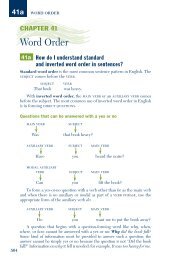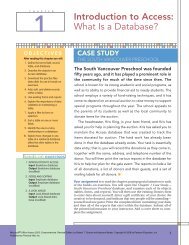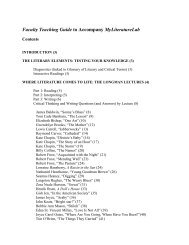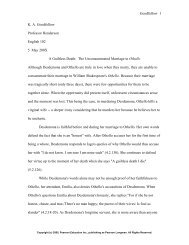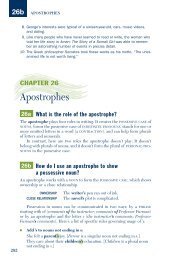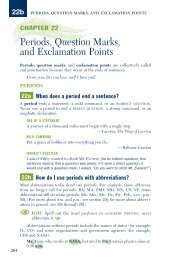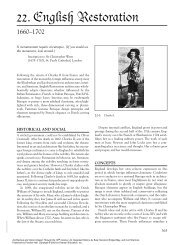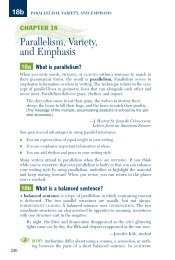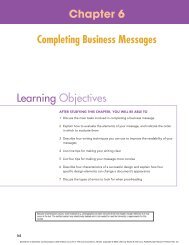JavaScript/JScript: Control Structures I - Pearson Learning Solutions
JavaScript/JScript: Control Structures I - Pearson Learning Solutions
JavaScript/JScript: Control Structures I - Pearson Learning Solutions
Create successful ePaper yourself
Turn your PDF publications into a flip-book with our unique Google optimized e-Paper software.
2008934301<br />
Chapter 14 <strong>JavaScript</strong>/<strong>JScript</strong>: <strong>Control</strong> <strong>Structures</strong> I 417<br />
Here, only the sequence structure has been used—the steps listed are to be executed in order,<br />
one after the other.<br />
Software Engineering Observation 14.7<br />
Each refinement, as well as the top itself, is a complete specification of the algorithm; only<br />
the level of detail varies. 14.7<br />
To proceed to the next level of refinement (the second refinement), we commit to specific<br />
variables. We need a running total of the numbers, a count of how many numbers have<br />
been processed, a variable to receive the string representation of each grade as it is input, a<br />
variable to store the value of the grade after it is converted to an integer and a variable to<br />
hold the calculated average. The pseudocode statement<br />
Initialize variables<br />
may be refined as follows:<br />
Initialize total to zero<br />
Initialize gradeCounter to zero<br />
Notice that only the variables total and gradeCounter are initialized before they are used;<br />
the variables average, grade and gradeValue (for the calculated average, the user input and<br />
the integer representation of the grade, respectively) need not be initialized, because their<br />
values are determined as they are calculated or input.<br />
The pseudocode statement<br />
Input, sum up and count the quiz grades<br />
requires a repetition structure (a loop) that successively inputs each grade. Because we do<br />
not know how many grades are to be processed, we will use sentinel-controlled repetition.<br />
The user at the keyboard will type legitimate grades in one at a time. After the last legitimate<br />
grade is typed, the user will type the sentinel value. The program will test for the sentinel<br />
value after each grade is input and will terminate the loop when the sentinel value is<br />
entered by the user. The second refinement of the preceding pseudocode statement is then<br />
Input the first grade (possibly the sentinel)<br />
While the user has not as yet entered the sentinel<br />
Add this grade into the running total<br />
Add one to the grade counter<br />
Input the next grade (possibly the sentinel)<br />
Notice that in pseudocode, we do not use braces around the pseudocode that forms the body of<br />
the while structure. We simply indent the pseudocode under the while to show that it belongs<br />
to the body of the while. Remember, pseudocode is only an informal program development aid.<br />
The pseudocode statement<br />
Calculate and print the class average<br />
may be refined as follows:<br />
If the counter is not equal to zero<br />
Set the average to the total divided by the counter<br />
Print the average<br />
else<br />
Print “No grades were entered”<br />
e-Business and e-Commerce: How to Program, by Harvey M. Deitel, Paul J. Deitel, and Tem R. Nieto. Published by Prentice Hall.<br />
Copyright © 2001 by <strong>Pearson</strong> Education, Inc.




